世界卫生组织全球糖尿病报告
世卫组织 1999 年制定的糖尿病诊断与分型标准
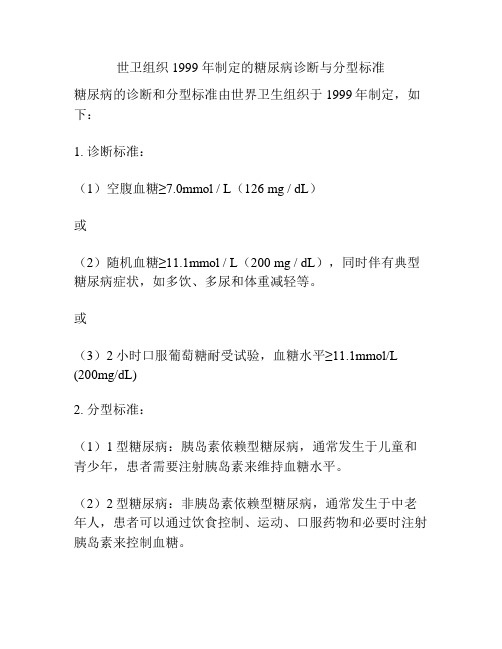
世卫组织 1999 年制定的糖尿病诊断与分型标准
糖尿病的诊断和分型标准由世界卫生组织于1999年制定,如下:
1. 诊断标准:
(1)空腹血糖≥7.0mmol / L(126 mg / dL)
或
(2)随机血糖≥11.1mmol / L(200 mg / dL),同时伴有典型糖尿病症状,如多饮、多尿和体重减轻等。
或
(3)2小时口服葡萄糖耐受试验,血糖水平≥11.1mmol/L (200mg/dL)
2. 分型标准:
(1)1型糖尿病:胰岛素依赖型糖尿病,通常发生于儿童和青少年,患者需要注射胰岛素来维持血糖水平。
(2)2型糖尿病:非胰岛素依赖型糖尿病,通常发生于中老年人,患者可以通过饮食控制、运动、口服药物和必要时注射胰岛素来控制血糖。
(3)其他类型的糖尿病:包括由基因变异、胰腺疾病、感染、药物或化学物质等引起的糖尿病。
糖尿病2023报告

糖尿病2023报告引言糖尿病,一种常见的慢性代谢性疾病,由于胰岛素不足或胰岛素功能障碍引起的高血糖症状而特征。
根据国际糖尿病联合会(IDF)的数据,全球约有4.64亿患者患有糖尿病(2019年至2022年期间)。
这一数字预计在2023年将超过5亿。
1. 糖尿病流行病学1.1 全球糖尿病患病率根据IDF的数据显示,全球糖尿病患病率在过去几十年内大幅上升。
预计到2023年,全球糖尿病患者数量将继续增加。
亚洲、北美洲和欧洲是糖尿病患病率最高的地区。
1.2 年龄和性别的影响糖尿病的患病率随着年龄的增长而增加,尤其是60岁以上的老年人。
然而,近年来,青少年和儿童糖尿病的患病率也在上升。
从性别角度来看,女性患糖尿病的比例略高于男性。
1.3 预测未来趋势根据趋势分析,预计糖尿病在未来几年内将继续增长。
这一趋势主要受到不健康的生活方式、肥胖和老龄化人口的影响。
2. 糖尿病的风险因素2.1 遗传因素糖尿病有明显的家族聚集现象,遗传因素在糖尿病的发病中起到了重要作用。
研究显示,有亲属患糖尿病的人患病风险较高。
2.2 肥胖和不健康的饮食习惯肥胖和不健康的饮食习惯是糖尿病发病的主要风险因素之一。
高热量、高脂肪和高糖分的饮食,以及缺乏蔬菜和水果的摄入,都会增加患糖尿病的风险。
2.3 缺乏体力活动缺乏体力活动是导致糖尿病的另一个重要因素。
久坐不动和缺乏运动会导致身体无法有效利用血糖,从而增加患糖尿病的风险。
3. 糖尿病管理和治疗3.1 生活方式改变生活方式的改变对于糖尿病管理至关重要。
建立健康的饮食习惯,控制体重,增加体育锻炼和减少长时间久坐,可以显著降低糖尿病的风险。
3.2 药物治疗对于患有糖尿病的患者,药物治疗是必要的。
胰岛素和口服降糖药物是常见的治疗药物,能够帮助控制血糖水平。
然而,药物治疗只能起到辅助作用,良好的生活方式仍然是糖尿病管理的关键。
4. 糖尿病对健康和经济的影响糖尿病对个人和社会的影响非常广泛。
糖尿病患者容易出现并发症,包括心血管疾病、肾脏疾病、视网膜病变等。
2024联合国糖尿病日主题

2024联合国糖尿病日主题
2024年的联合国糖尿病日的主题为:《为糖尿病病人和家庭建立支持环境》。
糖尿病是全世界人口中普遍存在的一种慢性疾病,会影响到人们的一生。
根据世界卫生组织(WHO)的数据,全世界有超过420万人死于糖尿病相关疾病,而且有超过3.6亿人患有糖尿病。
糖尿病不仅仅对患者本人造成影响,还会影响到他们的家庭,特别是他们的孩子。
因此,我们必须开展努力,为患有糖尿病的患者及其家人建立一个安全、有效、全面的支持环境,来改善他们的质量和健康状况。
首先,政府和社会各界应该合作,加大对糖尿病的资金投入,以改善现有的检测、治疗和疾病管理工作。
其次,应加强社会和健康教育,通过教育和宣传,使更多的人了解糖尿病,增强自我保护意识,减少糖尿病的发病率。
另外,应积极推行合理有效的药物政策,以减轻糖尿病患者的负担,使他们能够及时、规律地接受治疗。
此外,应建立完善的支持性环境,各界应该采取政策和行动,帮助糖尿病患者和家庭更好地照顾自己,减轻他们的心里压力,提高他们的治疗就诊率和临床疗效。
世界卫生组织全球糖尿病报告
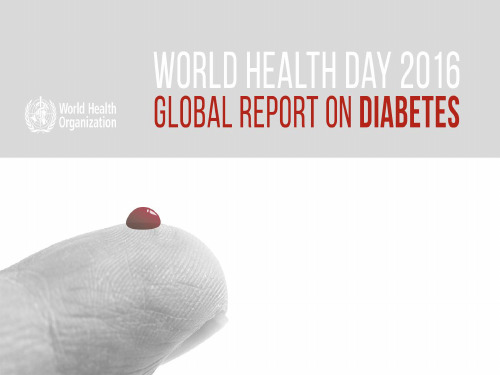
and
metabolic factors
Overweight/obesity and physical inactivity are the strongest
risk factors
Fetal & early childhood nutrition affect future risk
Complications of diabetes
Diabetes
Non-communicable diseases
Cancer
Chronic lung disease
Risk factors
Type 1
Exact causes are unknown.
Type 2
Risk is determined by genetic
Preventing type 2 diabetes at the population level
Multisectoral approaches
to reduce the prevalence of modifiable diabetes risk factors
A combination of
Diet and physical activity are more effective than medication.
The high-risk approach needs to be implemented in accordance with available resources.
108 millio
n
1980
Rise in diabetes
422 millio
世界卫生组织-2016年糖尿病数据
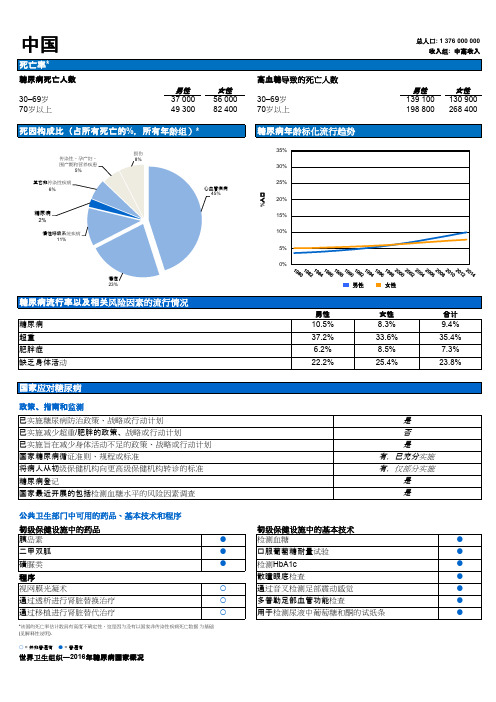
初级保健设施中的药品
胰岛素
●
二甲双胍
●
磺脲类
●
程序
视网膜光凝术
○
通过透析进行肾脏替换治疗
○
通过移植进行肾脏替代治疗
○
*该国的死亡率估计数具有高度不确定性,这是因为没有以国家非传染性疾病死亡数据 为基础 (见解释性说明).
● 〇 = 并非普遍有 = 普遍有
世界卫生组织—2016年糖尿病国家概况
总人口: 1 376 000 000 收入组: 中高收入
高血糖导致的死亡人数
30–69岁 70岁以上
糖尿病年龄标化流行趋势
男性 139 100 198 800
女性 130 900 268 400
%人 口
35%
30%
25%
20%
15%
没有可用数据
10%
5%
0%
男性
女性
男性 10.5% 37.2% 6.2% 22.2%
女性 8.3% 33.6% 8.5% 25.4%
合计 9.4% 35.4% 7.3% 23.8%
是 否 是 有,已充分实施 有,仅部分实施 是 是
初级保健设施中的基本技术
检测血糖
●
口服葡萄糖耐量试验
●
检测HbA1c
●
散瞳眼底检查
●
通过音叉检测足部震动感觉
●
多普勒足部血管功能检查
●
用于检测尿液中葡萄糖和酮的试纸条
糖尿病流行率以及相关风险因素的流行情况
糖尿病 超重 肥胖症 缺乏身体活动
国家应对糖尿病
政策、指南和监测 已实施糖尿病防治政策、战略或行动计划 已实施减少超重/肥胖的政策、战略或行动计划 已实施旨在减少身体活动不足的政策、战略或行动计划 国家糖尿病循证准则、规程或标准 将病人从初级保健机构向更高级保健机构转诊的标准 糖尿病登记 国家最近开展的包括检测血糖水平的风险因素调查
糖尿病及其分类和诊断标准
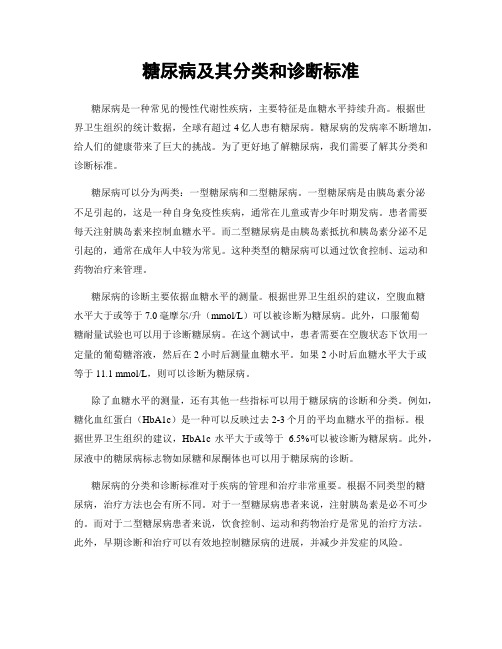
糖尿病及其分类和诊断标准糖尿病是一种常见的慢性代谢性疾病,主要特征是血糖水平持续升高。
根据世界卫生组织的统计数据,全球有超过4亿人患有糖尿病。
糖尿病的发病率不断增加,给人们的健康带来了巨大的挑战。
为了更好地了解糖尿病,我们需要了解其分类和诊断标准。
糖尿病可以分为两类:一型糖尿病和二型糖尿病。
一型糖尿病是由胰岛素分泌不足引起的,这是一种自身免疫性疾病,通常在儿童或青少年时期发病。
患者需要每天注射胰岛素来控制血糖水平。
而二型糖尿病是由胰岛素抵抗和胰岛素分泌不足引起的,通常在成年人中较为常见。
这种类型的糖尿病可以通过饮食控制、运动和药物治疗来管理。
糖尿病的诊断主要依据血糖水平的测量。
根据世界卫生组织的建议,空腹血糖水平大于或等于7.0毫摩尔/升(mmol/L)可以被诊断为糖尿病。
此外,口服葡萄糖耐量试验也可以用于诊断糖尿病。
在这个测试中,患者需要在空腹状态下饮用一定量的葡萄糖溶液,然后在2小时后测量血糖水平。
如果2小时后血糖水平大于或等于11.1 mmol/L,则可以诊断为糖尿病。
除了血糖水平的测量,还有其他一些指标可以用于糖尿病的诊断和分类。
例如,糖化血红蛋白(HbA1c)是一种可以反映过去2-3个月的平均血糖水平的指标。
根据世界卫生组织的建议,HbA1c水平大于或等于 6.5%可以被诊断为糖尿病。
此外,尿液中的糖尿病标志物如尿糖和尿酮体也可以用于糖尿病的诊断。
糖尿病的分类和诊断标准对于疾病的管理和治疗非常重要。
根据不同类型的糖尿病,治疗方法也会有所不同。
对于一型糖尿病患者来说,注射胰岛素是必不可少的。
而对于二型糖尿病患者来说,饮食控制、运动和药物治疗是常见的治疗方法。
此外,早期诊断和治疗可以有效地控制糖尿病的进展,并减少并发症的风险。
总之,糖尿病是一种世界范围内广泛存在的代谢性疾病。
了解糖尿病的分类和诊断标准对于疾病的管理和治疗至关重要。
通过血糖水平的测量以及其他指标的评估,可以准确地诊断糖尿病,并为患者提供合适的治疗方案。
世卫组织呼吁采取全球行动-WorldHealthOrganization

2016年世界卫生日:世卫组织呼吁采取全球行动,遏制糖尿病患者的增加并改善对其的护理第一份世卫组织《全球糖尿病报告》:4.22亿成年人患糖尿病,主要是在发展中国家2016年4月6日/日内瓦:世界卫生组织(世卫组织)在世界卫生日之前称,1980年以来,糖尿病患者人数增加了三倍,达4.22亿人,大多数生活在发展中国家。
导致这一激增的因素包括超重和肥胖症。
世卫组织将在纪念本组织1948年创立的年度世界卫生日(4月7日)之际,呼吁就糖尿病采取行动。
世卫组织在其第一份《全球糖尿病报告》中强调,需要加强对这一疾病的预防和治疗。
需要采取的措施包括扩展有助于健康的环境,以减少糖尿病风险因素,例如身体活动不足和不健康的饮食等,同时加强国家能力,帮助糖尿病患者获得管理其身体状况的必要治疗和护理。
“要想在遏制糖尿病增加方面取得进展,就需要反思我们的日常生活:注意健康进食,积极活动,避免体重增加过多,”世卫组织总干事陈冯富珍博士说。
“即使在最贫穷的环境下,政府也必须确保民众能够作出这些健康的选择,卫生系统也能够对糖尿病患者作出诊断和治疗。
”糖尿病是慢性的、渐进性的非传染性疾病,以血液内葡萄糖(血糖)水平不断升高为特征,其发生或是因为胰腺不能分泌足够的胰岛素来调整血糖,或是因为身体不能有效使用其所分泌的胰岛素。
《全球糖尿病报告》的主要结论是:–在世界各个地区,糖尿病的患病人数都在不断增加,流行程度也不断加剧。
2014年,有4.22亿人(或人口的8.5%)患有糖尿病,相形之下,1980年则为1.08亿人(4.7%)。
–糖尿病的流行产生了重大的健康和社会经济影响,尤其是在发展中国家。
–2014年,18岁以上成年人,每三人即有一人以上超重,每十人即有一人以上肥胖。
–糖尿病的并发症可导致心脏病发作、中风、失明、肾功能衰竭和下肢截肢。
例如,糖尿病患者的下肢截肢率为正常人的10到20倍。
–2012年,糖尿病导致150万例死亡。
血糖超出理想值,因为增加了心血管疾病和其他疾病的风险,造成了另外220万例死亡。
糖尿病的研究现状及进展

糖尿病的研究现状及进展糖尿病是一种常见的慢性疾病,世界卫生组织估计全球已经有超过4亿的人口患有糖尿病,而这个数字还在不断增加。
糖尿病给患者的生活带来很大的困扰,同时也对社会造成了巨大的经济负担。
因此,对糖尿病的研究成为了科学界的一项紧迫任务。
糖尿病是由于胰岛素分泌不足或者细胞对胰岛素不敏感而引起的高血糖症。
目前,研究人员主要关注于糖尿病的病因、诊断和治疗等方面,旨在揭示糖尿病发生的机制,并为糖尿病的预防和治疗提供科学依据。
近年来,研究人员对糖尿病病因进行了深入的研究,发现遗传和环境因素都与糖尿病的发生有密切关系。
例如,研究人员发现某些基因突变与糖尿病的遗传易感性有关,这些基因突变可能导致胰岛素分泌异常或胰岛素作用受损。
此外,生活方式因素,如饮食结构、体育锻炼和肥胖等也对糖尿病的发病率产生重要影响。
诊断糖尿病是糖尿病研究的重要方向之一。
传统上,诊断糖尿病主要依靠血糖测定,但这种方法在诊断糖耐量减低(IGT)和隐匿糖尿病方面存在不足之处。
因此,研究人员开展了大量工作,试图发现更加准确、敏感的糖尿病诊断方法。
例如,研究人员发现血中一些特定的代谢产物或标志物与糖尿病的发生有关,这为糖尿病诊断提供了新的思路和方法。
在治疗方面,胰岛素疗法是目前糖尿病治疗的主要手段之一。
然而,胰岛素疗法存在疗效不稳定、依从性差等问题。
因此,研究人员正在不断努力寻找新的治疗方法。
近年来,干细胞治疗被广泛关注。
干细胞具有自我更新和多向分化的能力,可以转化为胰岛β细胞,从而恢复胰岛素分泌功能。
虽然干细胞治疗在实际应用中还存在许多问题,但其潜力无疑给糖尿病的治疗带来了新的希望。
除了传统的治疗方法外,研究人员还探索了一系列的新的治疗策略。
例如,通过基因治疗干预基因突变导致的胰岛素分泌异常,或者通过免疫疗法调节免疫系统,改变糖尿病的发病机制。
这些新的治疗策略虽然还处于实验阶段,但显示出了巨大的潜力。
此外,糖尿病的预防也成为了研究关注的焦点。
糖尿病ada标准和who标准

糖尿病的诊断标准随着研究进展和技术更新会有所调整,下面概述的是截至我记忆截止日期(2024年3月4日) ADA(美国糖尿病学会)和WHO(世界卫生组织)的诊断标准要点:
美国糖尿病学会(ADA)标准(2024年最新版):
1.具有典型糖尿病症状(如多尿、多饮、多食、不明原因体重下降)并且满足
以下任何一项即可诊断糖尿病:
o糖化血红蛋白(HbA1c)≥6.5%(NGSP认证实验室,使用标准化方法检测)。
o空腹血糖(FPG)≥7.0mmol/L(至少8小时未摄入热量)。
o口服葡萄糖耐量试验(OGTT)2小时血糖≥11.1mmol/L(使用75克无水葡萄糖负荷试验)。
o随机血糖(任意时间)≥11.1mmol/L。
诊断通常需要在两个不同时间点获得两项异常测试结果,但如果患者表现出明显的糖尿病症状且有一项血糖值达到上述阈值,则无需等待第二次检测结果。
世界卫生组织(WHO)标准(最后一次修订时间未明,但以前的标准可参考):
1.具有典型糖尿病症状,并且满足以下任意一条可诊断糖尿病:
o空腹血糖(FPG)≥7.0mmol/L(至少禁食8小时)。
o随机血糖(任意时间)≥11.1mmol/L。
o OGTT 2小时血糖≥11.1mmol/L。
请注意,实际情况中,医疗专业人员可能会依据最新的指南或当地的临床实践来诊断糖尿病,因此建议就医时咨询当地医疗机构获取最准确的诊断标准。
由于医学指南时常更新,建议查阅最新的官方资料以获取最准确的信息。
世界卫生组织1999年糖尿病诊断标准英文版

世界卫生组织1999年糖尿病诊断标准英文版全文共3篇示例,供读者参考篇1World Health Organization 1999 Diabetes Diagnosis CriteriaIn 1999, the World Health Organization (WHO) released updated guidelines for the diagnosis of diabetes mellitus. These guidelines aim to provide a standardized approach to diagnosing diabetes, which is essential for proper management and treatment of the condition. The criteria set forth by the WHO in 1999 have since been widely adopted by healthcare professionals around the world.The WHO 1999 criteria for the diagnosis of diabetes mellitus are based on measurements of fasting plasma glucose (FPG) and oral glucose tolerance test (OGTT) results. According to these criteria, a diagnosis of diabetes can be made if any one of the following conditions is met:1. Fasting Plasma Glucose (FPG) ≥126 mg/dl (7.0 mmol/L): A fasting plasma glucose level of 126 mg/dl or higher indicates diabetes. Fasting means that the individual has not consumedany food or beverages other than water for at least 8 hours prior to the test.2. 2-Hour Plasma Glucose ≥ 200mg/dl (11.1 mmol/L) during an Oral Glucose Tolerance Test (OGTT): An OGTT involves drinking a glucose solution after fasting overnight, then testing blood glucose levels 2 hours later. A result of 200 mg/dl or higher indicates diabetes.3. Casual Plasma Glucose ≥ 200mg/dl (11.1 mmol/L): If an individual has symptoms of hyperglycemia (e.g., increased thirst, frequent urination) and a random plasma glucose level of 200 mg/dl or higher, a diagnosis of diabetes can be made.It is important to note that these diagnostic criteria are meant to be used in non-pregnant individuals. For pregnant women, the WHO recommends using different criteria to diagnose gestational diabetes.The WHO 1999 criteria also include guidelines for the diagnosis of impaired fasting glucose (IFG) and impaired glucose tolerance (IGT), which are conditions that precede diabetes and increase the risk of developing the disease. According to these guidelines, IFG is defined as a fasting plasma glucose level of 110-125 mg/dl (6.1-6.9 mmol/L), while IGT is diagnosed if the2-hour plasma glucose level during an OGTT is between 140-199 mg/dl (7.8-11.0 mmol/L).Diabetes is a chronic condition that affects millions of people worldwide and can lead to serious complications if not properly managed. By using standardized diagnostic criteria such as those set forth by the WHO in 1999, healthcare professionals can accurately identify individuals with diabetes and initiate appropriate treatment and monitoring to prevent complications and improve outcomes.In conclusion, the World Health Organization 1999 diabetes diagnosis criteria have become the gold standard for diagnosing diabetes mellitus worldwide. These criteria provide clear guidelines for healthcare professionals to identify individuals with diabetes and ensure they receive the necessary care and treatment. By following these criteria, healthcare providers can effectively manage diabetes and improve the quality of life for those affected by this chronic condition.篇2World Health Organization 1999 Diabetes Diagnosis CriteriaIn 1999, the World Health Organization (WHO) revised the diagnostic criteria for diabetes in order to better reflect thecurrent understanding of the disease. These criteria are important in accurately identifying individuals who have diabetes and ensuring they receive appropriate treatment and care. The 1999 WHO criteria for diabetes diagnosis are as follows:1. Fasting Plasma Glucose (FPG) Level:- Normal: FPG < 6.1 mmol/L (110 mg/dL)- Impaired Fasting Glucose (IFG): FPG 6.1-6.9 mmol/L (110-125 mg/dL)- Diabetes: FPG ≥ 7.0 mmol/L (126 mg/dL)2. 2-hour Plasma Glucose Level after Oral Glucose Tolerance Test (OGTT):- Normal: < 7.8 mmol/L (140 mg/dL)- Impaired Glucose Tolerance (IGT): 7.8-11.0 mmol/L (140-199 mg/dL)- Diabetes: ≥ 11.1 mmol/L (200 mg/dL)3. Symptoms of hyperglycemia and casual plasma glucose concentration ≥ 11.1 mmol/L (200 mg/dL) indicate the presence of diabetes.It is important to note that these criteria were established based on evidence that individuals with glucose levels above the specified thresholds have an increased risk of developing diabetes-related complications. Additionally, the WHO recommends that the diagnosis of diabetes should be confirmed by repeating the test on a different day if the results are borderline or inconsistent.These diagnostic criteria have been widely adopted by healthcare professionals around the world and are used to identify individuals with diabetes, prediabetes, and normal glucose metabolism. Early detection and management of diabetes are crucial in preventing complications such as cardiovascular disease, kidney failure, blindness, and lower limb amputations.In addition to the diagnostic criteria, the WHO also emphasizes the importance of lifestyle modifications, including a healthy diet, regular physical activity, and weight management, in the prevention and management of diabetes. Individuals with diabetes are also advised to monitor their blood glucose levels regularly, take prescribed medications as directed, and seek medical advice if they experience any symptoms of hyperglycemia or hypoglycemia.Overall, the 1999 WHO diabetes diagnosis criteria provide a standardized approach to identifying individuals with diabetes and ensuring they receive appropriate care and management. By following these criteria, healthcare professionals can accurately diagnose diabetes, initiate timely interventions, and help individuals lead healthier lives.篇3World Health Organization 1999 Diabetes Diagnostic CriteriaIntroductionDiabetes is a chronic disease that affects millions of people worldwide. In 1999, the World Health Organization (WHO) released updated diagnostic criteria for diabetes in an effort to provide more accurate and consistent guidelines for diagnosing the disease. This document outlines the key criteria outlined by the WHO for diagnosing diabetes.Criteria for Diagnosis1. Fasting Plasma Glucose (FPG) Test: One of the most common tests used to diagnose diabetes is the fasting plasma glucose test. In this test, a person is required to fast for at least 8 hours before having their blood glucose levels measured. Ablood glucose level of 126 mg/dL (7.0 mmol/L) or higher on two separate occasions is indicative of diabetes.2. Oral Glucose Tolerance Test (OGTT): Another test that can be used to diagnose diabetes is the oral glucose tolerance test. In this test, a person is required to fast for at least 8 hours before consuming a glucose solution. Blood glucose levels are then measured 2 hours after consuming the solution. A blood glucose level of 200 mg/dL (11.1 mmol/L) or higher is indicative of diabetes.3. HbA1c Test: The HbA1c test, also known as the glycated hemoglobin test, measures the average blood glucose levels over the past 2-3 months. A HbA1c level of 6.5% or higher is indicative of diabetes.4. Symptoms of Diabetes: In some cases, a person may present with classic symptoms of diabetes such as frequent urination, increased thirst, unexplained weight loss, and fatigue. If these symptoms are present along with a random plasma glucose level of 200 mg/dL (11.1 mmol/L) or higher, diabetes can be diagnosed.5. Gestational Diabetes: In pregnant women, gestational diabetes can develop. The diagnostic criteria for gestational diabetes are a bit different, with a 75g oral glucose tolerance testand the following cutoff va lues: Fasting glucose ≥92 mg/dL (5.1 mmol/L), 1-hour ≥180 mg/dL (10.0 mmol/L), and 2-hour ≥153 mg/dL (8.5 mmol/L).ConclusionThe 1999 WHO diabetes diagnostic criteria provide healthcare professionals with clear guidelines for diagnosing diabetes. By using these criteria, healthcare providers can accurately identify individuals with diabetes and provide appropriate treatment and management strategies. It is important to note that diagnosing diabetes early can help prevent complications and improve outcomes for patients with the disease.。
世卫组织 1999 年制定的糖尿病诊断与分型标准

世卫组织 1999 年制定的糖尿病诊断与分型标准糖尿病是一种常见的慢性代谢性疾病,它的主要特征是体内胰岛素分泌不足或胰岛素作用受阻,从而导致血糖水平升高。
根据世界卫生组织(WHO)1999年制定的标准,糖尿病的诊断和分类依据体内的葡萄糖水平和胰岛素分泌情况。
糖尿病的分类糖尿病的分类依据病因和代谢的特点,包括两种类型:一型糖尿病和二型糖尿病。
一型糖尿病一型糖尿病是指胰岛β细胞自身免疫性损伤导致胰岛素分泌不足,血糖水平无法被有效控制的糖尿病。
患者的胰岛素分泌减少,导致葡萄糖不能被组织利用,故而病情会迅速恶化。
患者必须使用胰岛素来控制血糖水平。
二型糖尿病二型糖尿病是指身体对胰岛素的敏感性下降、胰岛纤维化或存在胰岛细胞不足等引起的糖尿病。
患者常常症状不很明显,可逐渐出现多种症状,如视力模糊、口渴等,往往需要使用胰岛素或其他药物进行治疗。
糖尿病的诊断标准世界卫生组织于1999年制定了糖尿病诊断和分类的标准,此标准适用于临床和流行病学中,也被广泛应用于全球各地。
糖尿病的诊断基于测量空腹血糖和随机血糖水平。
空腹血糖诊断糖尿病的首要指标是评估空腹血糖水平。
空腹血糖是指在12小时以上不进食任何食物或饮料,及至少8小时不喝水的情况下进行的血糖测定。
对于空腹血糖水平的诊断,应使用含有标准量量测器的计量设备进行,一般情况下,正常成年人的空腹血糖水平应低于6.1mmol/L,而处于糖尿病前期的人群则应该介于6.1~6.9mmol/L。
随机血糖随机血糖是指在任意时间进行的血糖测量,无论是否进食或饮水,都可以进行。
诊断糖尿病的随机血糖水平应当大于11.1mmol/L。
如果随机血糖大于7.8mmol/L且症状明显,也应该进行进一步检测以确认糖尿病。
葡萄糖耐量试验葡萄糖耐量试验可以测量在饮食后血糖的变化。
患者应在餐前吃下75克的葡萄糖,此时检测血糖水平,然后在2小时后再次进行检测。
如果2小时后血糖水平高于7.8mmol/L,则表示可能患有糖尿病。
最新全球糖尿病地图:中国糖尿病患者达1.164亿,居世界第一
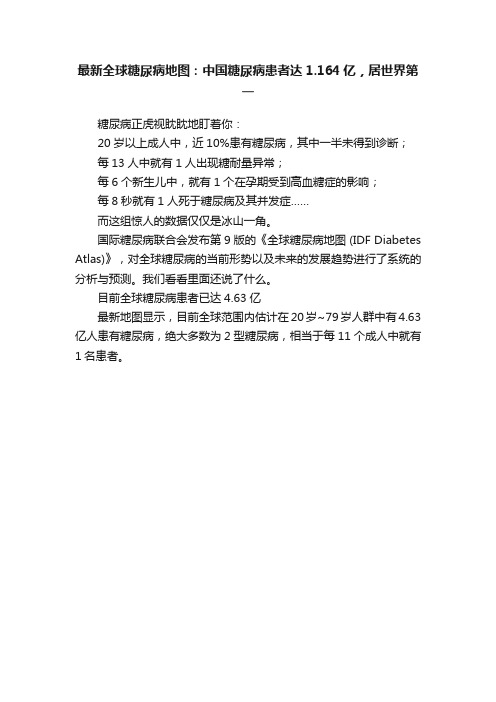
最新全球糖尿病地图:中国糖尿病患者达1.164亿,居世界第一糖尿病正虎视眈眈地盯着你:20岁以上成人中,近10%患有糖尿病,其中一半未得到诊断;每13人中就有1人出现糖耐量异常;每6个新生儿中,就有1个在孕期受到高血糖症的影响;每8秒就有1人死于糖尿病及其并发症……而这组惊人的数据仅仅是冰山一角。
国际糖尿病联合会发布第9版的《全球糖尿病地图 (IDF Diabetes Atlas)》,对全球糖尿病的当前形势以及未来的发展趋势进行了系统的分析与预测。
我们看看里面还说了什么。
目前全球糖尿病患者已达4.63亿最新地图显示,目前全球范围内估计在20岁~79岁人群中有4.63亿人患有糖尿病,绝大多数为2型糖尿病,相当于每11个成人中就有1名患者。
对全球20岁~79岁糖尿病患病率的估计(百万)(2019年)到2030年与2045年,预计这一数字将分别达到5.78亿(10.2%)与7亿(10.9%)。
全球一半成年人不知道自己患有糖尿病更为恐怖的是全球成人糖尿病患者中,50.1%竟不知道自己患病。
成人未诊糖尿病人数和比例(2019年)由于缺乏医疗服务机会,低收入国家未确诊的患者比例最高,达66.8%,但在高收入国家,也有38.3%的患者未得到确诊。
IDF报告指出:全球糖尿病患者中有32%患有心血管疾病;超过80%的终末期肾脏疾病是由糖尿病或高血压或两者同时引起;糖尿病足和下肢并发症影响4000万~6000万糖尿病患者。
糖尿病“间接代价”巨大2型糖尿病和高体重指数还会增加许多常见癌症的风险,包括肝癌、胰腺癌、子宫内膜癌、结直肠癌、乳腺癌等……全球全因死亡率中,大约11.3%与糖尿病相关,20岁~79岁年龄段糖尿病相关死亡人群中大约一半(46.2%)为60岁以下人群。
糖尿病导致的过早死亡和残疾已经对国家经济增长造成了负面影响,这被称为糖尿病“间接代价”。
全球1/4糖尿病患者来自中国中国作为糖尿病负担突出的国家之一,在最新地图中多次被点名。
糖尿病筛查率不达标汇报总结

糖尿病筛查率不达标汇报总结糖尿病是一种慢性疾病,严重影响患者的生活质量。
根据世界卫生组织的数据显示,全球已有4.63亿人患有糖尿病,而在中国这一数字更是高达1.16亿。
糖尿病的高发病率和相关并发症严重影响了公民的健康与生活。
因此,糖尿病筛查的重要性不言而喻。
然而,目前我国糖尿病筛查率并不理想,许多地区的筛查率还远远低于标准,这给公民的健康带来了巨大风险。
1.糖尿病筛查的重要性糖尿病是一种慢性代谢性疾病,患者可能在长期内不知情就患上糖尿病。
而随着社会的快速发展和生活方式的改变,糖尿病病例不断增加。
糖尿病早期诊断,早期治疗更有利于延缓疾病的发展和减少并发症的出现。
因此,糖尿病筛查是十分重要的,只有及早发现并干预疾病,才能有效降低疾病的发病率和死亡率。
2.我国糖尿病筛查率不达标的原因我国糖尿病筛查率不达标的原因有以下几点:第一,公众的糖尿病认知水平偏低。
一些居民对糖尿病的认识有限,不了解糖尿病的发病原因和危害性,甚至觉得这并不是一种严重的疾病。
因此,他们对进行糖尿病筛查的意识和主动性并不高。
第二,医疗资源不足。
在一些贫困地区和农村地区,医疗资源缺乏,医疗条件艰苦。
一些居民很难得到规范的医疗服务,也因此无法进行糖尿病筛查。
第三,糖尿病筛查工作不够系统。
一些地方对糖尿病筛查的工作重视不够,没有建立完善的筛查机制和政策。
导致糖尿病筛查的覆盖率不够高。
3.提升糖尿病筛查率的建议首先,加强糖尿病相关知识的宣传。
通过各种形式的宣传教育,提高公众对糖尿病的认知水平,增强对糖尿病的预防和筛查的重视。
其次,加强医疗资源的配置。
特别是在农村地区,应该加大对基层医疗机构的支持,提高他们的技术能力和设备,使得更多的居民可以得到规范的糖尿病筛查服务。
再者,建立完善的筛查机制和政策。
在各级政府的支持下,建立健全的糖尿病筛查机制和政策,保障糖尿病筛查工作的顺利开展和覆盖率的提高。
最后,加大对糖尿病筛查的投入。
政府和社会应该加大对糖尿病筛查工作的投入,从人力、财力和物力等方面提供支持,促进糖尿病筛查率的提高。
2023世卫组织报告
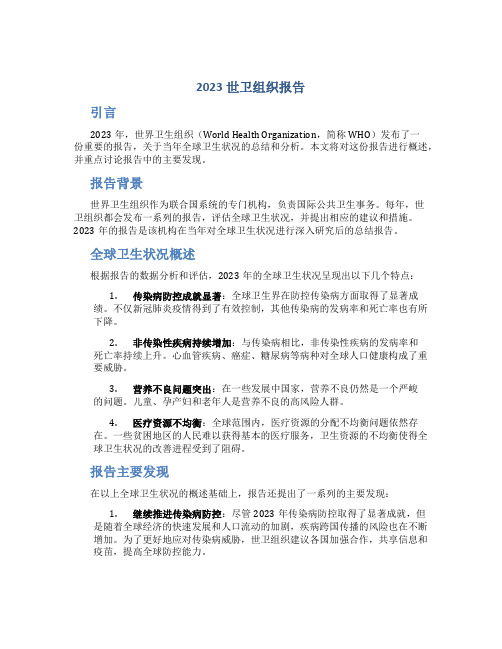
2023世卫组织报告引言2023年,世界卫生组织(World Health Organization,简称WHO)发布了一份重要的报告,关于当年全球卫生状况的总结和分析。
本文将对这份报告进行概述,并重点讨论报告中的主要发现。
报告背景世界卫生组织作为联合国系统的专门机构,负责国际公共卫生事务。
每年,世卫组织都会发布一系列的报告,评估全球卫生状况,并提出相应的建议和措施。
2023年的报告是该机构在当年对全球卫生状况进行深入研究后的总结报告。
全球卫生状况概述根据报告的数据分析和评估,2023年的全球卫生状况呈现出以下几个特点:1.传染病防控成就显著:全球卫生界在防控传染病方面取得了显著成绩。
不仅新冠肺炎疫情得到了有效控制,其他传染病的发病率和死亡率也有所下降。
2.非传染性疾病持续增加:与传染病相比,非传染性疾病的发病率和死亡率持续上升。
心血管疾病、癌症、糖尿病等病种对全球人口健康构成了重要威胁。
3.营养不良问题突出:在一些发展中国家,营养不良仍然是一个严峻的问题。
儿童、孕产妇和老年人是营养不良的高风险人群。
4.医疗资源不均衡:全球范围内,医疗资源的分配不均衡问题依然存在。
一些贫困地区的人民难以获得基本的医疗服务,卫生资源的不均衡使得全球卫生状况的改善进程受到了阻碍。
报告主要发现在以上全球卫生状况的概述基础上,报告还提出了一系列的主要发现:1.继续推进传染病防控:尽管2023年传染病防控取得了显著成就,但是随着全球经济的快速发展和人口流动的加剧,疾病跨国传播的风险也在不断增加。
为了更好地应对传染病威胁,世卫组织建议各国加强合作,共享信息和疫苗,提高全球防控能力。
2.加大对非传染性疾病的关注:非传染性疾病的持续增加需要全球范围内的关注和行动。
世卫组织呼吁各国加强政策制定、促进健康生活方式,并提高医疗机构和医疗人员对非传染性疾病的预防和治疗能力。
3.解决营养不良问题:营养不良对儿童健康和成人健康都具有重要的影响。
糖尿病分析报告

糖尿病分析报告概述糖尿病是一种常见的慢性代谢性疾病,受到全球范围内的关注。
该疾病主要由胰岛素分泌不足或细胞对胰岛素反应不佳引起的高血糖症状而特征化。
糖尿病的发病率持续上升,已经成为世界卫生组织关注的重点疾病之一。
本报告将对糖尿病的一些关键方面进行分析,并提供相关统计数据和研究成果。
流行病学数据据世界卫生组织的统计数据显示,目前全球有约4.29亿人患有糖尿病,占世界总人口的8.5%。
预计到2030年,这一数字将增长到5.44亿人。
糖尿病的流行率在中低收入国家显著高于高收入国家,这可能与饮食结构、生活方式和社会经济因素等有关。
根据糖尿病类型的分类,大部分患者(约90%)为2型糖尿病,而10%的患者属于1型糖尿病。
此外,还有一些特殊类型的糖尿病,如妊娠期糖尿病和遗传性糖尿病等。
风险因素糖尿病的发病风险受到多个因素的影响。
以下是一些常见的糖尿病风险因素:1.高血压:高血压患者更容易患上糖尿病。
2.肥胖:肥胖是2型糖尿病的主要风险因素。
3.不健康的饮食:高糖、高脂肪和高盐的饮食习惯与糖尿病的发病风险增加有关。
4.缺乏体力活动:长期缺乏体力活动易导致肥胖和糖尿病。
5.遗传因素:有家族史的人更容易发展成糖尿病。
疾病管理糖尿病的管理涉及到多个方面,包括饮食控制、药物治疗和生活方式改变等。
以下是一些常见的治疗方法:1.药物治疗:糖尿病患者常常需要服用胰岛素或口服药物来控制血糖水平。
2.饮食控制:合理的饮食结构对糖尿病的管理非常重要。
患者应遵循营养均衡的原则,控制碳水化合物和脂肪的摄入。
3.体力活动:适度的体力活动可以帮助身体更好地利用血糖,并控制体重。
4.血糖监测:糖尿病患者需要定期监测血糖水平,以便调整治疗方案。
预防策略糖尿病的预防是一个重要的公共卫生问题。
以下是一些预防糖尿病的常见策略:1.健康的饮食:选择低糖、低脂肪和高纤维的食物,控制碳水化合物和脂肪的摄入量。
2.积极锻炼:每周进行适量的体力活动,如散步、跑步、游泳等。
糖尿病慢病管理

糖尿病慢病管理糖尿病是一种慢性疾病,全球范围内的病例数量不断增加。
根据世界卫生组织的数据,全球已有4.25亿糖尿病患者,并且这个数字还在持续上升。
糖尿病对人体的影响非常广泛,包括心血管疾病、肾脏问题、视力问题等。
因此,糖尿病的慢病管理对于患者的生活质量和健康至关重要。
糖尿病的慢病管理主要包括以下几个方面:合理的饮食控制、规律的体力活动、药物治疗和定期监测。
本文将逐一介绍这些管理措施。
首先,合理的饮食控制对于糖尿病患者来说至关重要。
他们需要控制摄入的糖分和碳水化合物的量,以维持血糖的稳定。
一般来说,糖尿病患者应该增加蔬菜和水果的摄入量,少吃高糖分的食物和饮料,尽量选择全谷类食物和低脂的蛋白质来源。
此外,均衡的饮食搭配也很重要,应确保膳食中包含足够的营养物质。
其次,规律的体力活动对于控制血糖水平非常有效。
适量的运动可以提高体内胰岛素的敏感性,帮助血糖更好地进入细胞。
糖尿病患者可以选择适合自己的体育项目,如散步、慢跑、游泳等有氧运动,每周至少进行150分钟的中等强度运动。
此外,力量训练也对于增强肌肉和骨骼有帮助,提高整体的代谢水平。
药物治疗是糖尿病患者慢病管理的重要环节。
根据患者的具体情况,医生可能会给予口服药物或注射胰岛素的治疗方案。
口服药物主要通过促进胰岛素的分泌或增加细胞对胰岛素的敏感性来降低血糖水平。
而注射胰岛素则可以直接补充体内胰岛素的不足。
根据医生的指导,患者需要严格按时服药或注射,不得擅自调整剂量。
最后,定期监测是糖尿病慢病管理的重要环节之一。
患者需要进行血糖监测,以便了解自己的血糖水平。
通过监测结果,患者可以及时进行调整饮食和药物治疗,并与医生沟通,共同制定合理的管理方案。
此外,患者还应进行定期的体检,以便及早发现并处理糖尿病可能引发的并发症。
除了上述的几个方面,糖尿病患者还需要保持良好的日常生活习惯。
他们应避免熬夜、过度劳累和压力过大,保持充足的睡眠和良好的精神状态。
此外,戒烟限酒也是非常重要的,因为吸烟和过量饮酒会增加糖尿病患者的心血管疾病和其他并发症的风险。
糖尿病判断标准
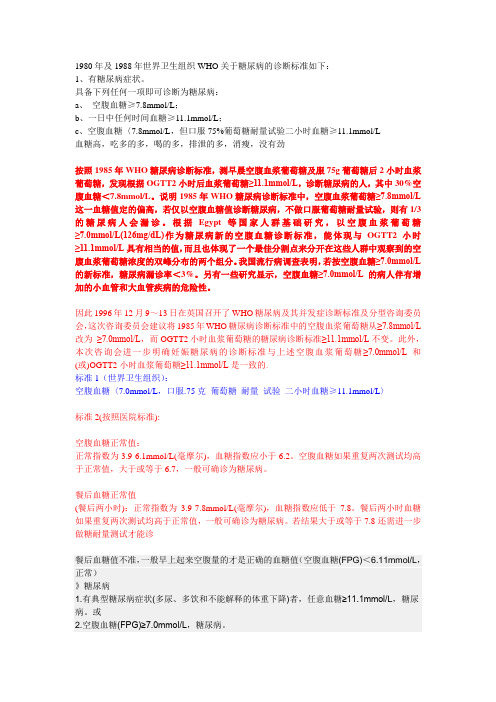
1980年及1988年世界卫生组织WHO关于糖尿病的诊断标准如下:1、有糖尿病症状。
具备下列任何一项即可诊断为糖尿病:a、空腹血糖≥7.8mmol/L;b、一日中任何时间血糖≥11.1mmol/L;c、空腹血糖〈7.8mmol/L,但口服75%葡萄糖耐量试验二小时血糖≥11.1mmol/L血糖高,吃多的多,喝的多,排泄的多,消瘦,没有劲按照1985年WHO糖尿病诊断标准,测早晨空腹血浆葡萄糖及服75g葡萄糖后2小时血浆葡萄糖,发现根据OGTT2小时后血浆葡萄糖≥11.1mmol/L,诊断糖尿病的人,其中30%空腹血糖<7.8mmol/L。
说明1985年WHO糖尿病诊断标准中,空腹血浆葡萄糖≥7.8mmol/L 这一血糖值定的偏高,若仅以空腹血糖值诊断糖尿病,不做口服葡萄糖耐量试验,则有1/3的糖尿病人会漏诊。
根据Egypt等国家人群基础研究,以空腹血浆葡萄糖≥7.0mmol/L(126mg/dL)作为糖尿病新的空腹血糖诊断标准,能体现与OGTT2小时≥11.1mmol/L具有相当的值,而且也体现了一个最佳分割点来分开在这些人群中观察到的空腹血浆葡萄糖浓度的双峰分布的两个组分。
我国流行病调查表明,若按空腹血糖≥7.0mmol/L 的新标准,糖尿病漏诊率<3%。
另有一些研究显示,空腹血糖≥7.0mmol/L的病人伴有增加的小血管和大血管疾病的危险性。
因此1996年12月9~13日在英国召开了WHO糖尿病及其并发症诊断标准及分型咨询委员会,这次咨询委员会建议将1985年WHO糖尿病诊断标准中的空腹血浆葡萄糖从≥7.8mmol/L 改为≥7.0mmol/L,而OGTT2小时血浆葡萄糖的糖尿病诊断标准≥11.1mmol/L不变。
此外,本次咨询会进一步明确妊娠糖尿病的诊断标准与上述空腹血浆葡萄糖≥7.0mmol/L和(或)OGTT2小时血浆葡萄糖≥11.1mmol/L是一致的。
标准1(世界卫生组织):空腹血糖〈7.0mmol/L,口服.75克葡萄糖耐量试验二小时血糖≥11.1mmol/L〉标准2(按照医院标准):空腹血糖正常值:正常指数为3.9-6.1mmol/L(毫摩尔),血糖指数应小于6.2。
- 1、下载文档前请自行甄别文档内容的完整性,平台不提供额外的编辑、内容补充、找答案等附加服务。
- 2、"仅部分预览"的文档,不可在线预览部分如存在完整性等问题,可反馈申请退款(可完整预览的文档不适用该条件!)。
- 3、如文档侵犯您的权益,请联系客服反馈,我们会尽快为您处理(人工客服工作时间:9:00-18:30)。
Non-communicable diseases
Diabetes
Cancer Chronic lung disease
Risk factors
Type 1
Exact causes are unknown.
Type 2
Risk is determined by genetic and metabolic factors Overweight/obesity and physical inactivity are the strongest risk factors Fetal & early childhood nutrition affect future risk
Scope of the report
Burden of diabetes Preventing diabetes Managing diabetes National response Recommendations
BURDEN OF DIABETES
Diabetes
is a serious, chronic disease characterized by elevated blood glucose occurs either when the pancreas does not produce enough insulin (type 1) or the body cannot effectively use the insulin it produces (type 2).
Diet and physical activity are more effective than medication.
The high-risk approach needs to be implemented in accordance with available resources.
Diabetes is one of the four major NCDs
Causative risk factors Tobacco use Heart disease and stroke Unhealthy diets Physical inactivity Harmful use of alcohol
management of other NCDs, and
in some settings with tuberculosis and HIV/AIDS.
NATIONAL RESPONSE
countries) 156 countries have a national diabetes policy, plan or strategy, only 127 are funded and operational.
High proportion of type 2 diabetes is undiagnosed.
Management of diabetes
Good management can prevent complications and premature death using:
standard guidelines and protocols (WHO Package of Essential NCD interventions) small set of generic medicines diet and physical activity patient education about self-care regular screening for early detection and treatment of complications.
Proper footwear and regular examination of feet Provide rehabilitation
Integrated management of diabetes and other chronic health conditions
Diabetes management should be integrated with
End-stage renal disease
Measurement of urine protein
Early detection and treatment of complications
progression to kidney failure can be slowed by essential drugs
Mortality from diabetes
Deaths due to high blood glucose
43% of deaths occurred under the age of 70 years
3.7 Million
Deaths due to diabetes
1.5 Million
Economic impact of diabetes
National capacity for prevention and control of diabetes (NCD CCS 2015- 177
68% of countries have operational policies for diet and physical activity. < 50% of countries have conducted a national, population-based survey with measurement of blood glucose status within the past 5 years.
School-based approach
Preventing type 2 diabetes in people at high risk
Diabetes can be delayed or prevented
in people who are overweight and have impaired glucose tolerance (IGT).
Cardiovascular diseases
Measure and control cardiovascular risk factors
Blindness
Periodic eye examinations and timely laser photocoagulation
Lower limb amputation
Blood glucose measurement is generally available in primary care in 50% of lowincome countries.
RECOMMENDATIONS
Recommendations
National mechanisms Build capacity of health ministries Prioritize prevention of overweight and obesity Strengthen health systems Address gaps in knowledge base Surveillance and monitoring • Establish high-level multisectoral commissions • Strategic leadership, engagement of stakeholders, implement policies and foster accountability • Life-course approach, create supportive environments, use fiscal policies and legislation • Enhance capacity of primary health care, national protocols for management, improve access to affordable medicines. • Outcome evaluations, operational research • Collect, analyse and use representative data, develop and strengthen diabetes registries if feasible.
MANAGING DIABETES
Diagnosing diabetes
Diabetes is diagnosed by
measuring glucose in blood
Fasting 2 hours after a 75g oral load of glucose
measuring glycated haemoglobin (HbA1c)
Access to affordable insulin
People with type 1 diabetes require insulin for survival. People with type 2 diabetes often need insulin
Low-income countries generally pay most for insulin while high- and middleincome countries pay least. Only 23% of low-income countries report that insulin is generally available.
SDG target- One third reduction in premature mortality from NCDs (including Diabetes)
